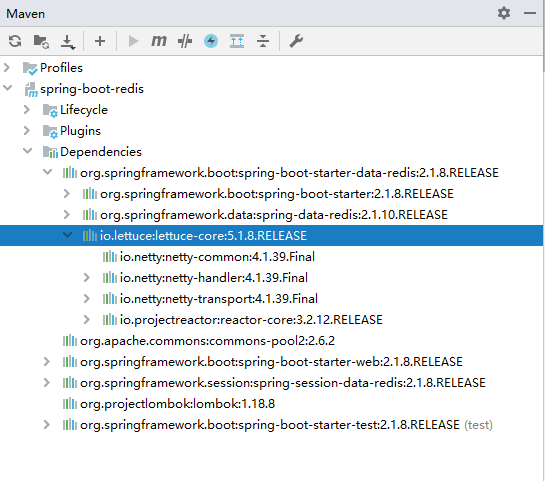
1. Redis 简介
Redis 是目前业界使用最广泛的内存数据存储。相比 Memcached,Redis 支持更丰富的数据结构,例如 hashes, lists, sets 等,同时支持数据持久化。除此之外,Redis 还提供一些类数据库的特性,比如事务,HA,主从库。可以说 Redis 兼具了缓存系统和数据库的一些特性,因此有着丰富的应用场景。本文介绍 Redis 在 Spring Boot 中两个典型的应用场景。
2. Lettuce 简介
如果在 Java 应用中使用过 Redis 缓存,那么对 Jedis 一定不陌生, Lettuce 和 Jedis 一样,都是连接 Redis Server 的客户端程序。Jedis 在实现上是直连 Redis Server,多线程环境下非线程安全,除非使用连接池,为每个 Jedis 实例增加物理连接。 Lettuce 基于 Netty 的连接实例(StatefulRedisConnection),可以在多个线程间并发访问,且线程安全,满足多线程环境下的并发访问,同时它是可伸缩的设计,一个连接实例不够的情况也可以按需增加连接实例。
3. Spring Boot 应用中使用方式
- 直接通过
RedisTemplate来使用 - 使用
Spring Cache集成Redis - 通过
Spring Session做Session共享
4. 工程实战
4.1 工程依赖 pom.xml 如下:
代码清单:spring-boot-redis/pom.xml
<dependencies>
<dependency>
<groupId>org.springframework.boot</groupId>
<artifactId>spring-boot-starter-data-redis</artifactId>
</dependency>
<dependency>
<groupId>org.apache.commons</groupId>
<artifactId>commons-pool2</artifactId>
</dependency>
<dependency>
<groupId>org.springframework.boot</groupId>
<artifactId>spring-boot-starter-web</artifactId>
</dependency>
<dependency>
<groupId>org.springframework.session</groupId>
<artifactId>spring-session-data-redis</artifactId>
</dependency>
<dependency>
<groupId>org.projectlombok</groupId>
<artifactId>lombok</artifactId>
<optional>true</optional>
</dependency>
<dependency>
<groupId>org.springframework.boot</groupId>
<artifactId>spring-boot-starter-test</artifactId>
<scope>test</scope>
</dependency>
</dependencies>
-
spring-boot-starter-data-redis :在
Spring Boot 2.x后底层不再是使用Jedis,而是换成了Lettuce,如图: -
commons-pool2 : 用作
redis连接池,如不引入启动会报错。 -
spring-session-data-redis :
Spring Session引入,用作共享Session。

4.2 配置文件 application.yml
代码清单:spring-boot-redis/src/main/resources/application.yml
server:
port: 8080
servlet:
session:
timeout: 30m
spring:
application:
name: spring-boot-redis
cache:
# 使用了Spring Cache后,能指定spring.cache.type就手动指定一下,虽然它会自动去适配已有Cache的依赖,但先后顺序会对Redis使用有影响(JCache -> EhCache -> Redis -> Guava)
type: REDIS
redis:
host: 192.168.0.128
port: 6379
password: 123456
# 连接超时时间(ms)
timeout: 10000
# Redis默认情况下有16个分片,这里配置具体使用的分片,默认是0
database: 0
lettuce:
pool:
# 连接池最大连接数(使用负值表示没有限制) 默认 8
max-active: 100
# 连接池最大阻塞等待时间(使用负值表示没有限制) 默认 -1
max-wait: -1
# 连接池中的最大空闲连接 默认 8
max-idle: 8
# 连接池中的最小空闲连接 默认 0
min-idle: 0
这里的配置不多解释,需要解释的已经标注注释。
4.3 RedisTemplate 使用方式
4.3.1 创建实体类 User.java
代码清单:spring-boot-redis/src/main/java/com/springboot/springbootredis/model/User.java
@Data
@AllArgsConstructor
@NoArgsConstructor
public class User implements Serializable {
private static final long serialVersionUID = 662692455422902539L;
private Long id;
private String name;
private int age;
}
4.3.2 自定义 RedisTemplate
默认情况下的模板只能支持 RedisTemplate<String, String> ,也就是只能存入字符串,这在开发中是不友好的,所以自定义模板是很有必要的,当自定义了模板又想使用 String 存储这时候就可以使用 StringRedisTemplate 的方式,它们并不冲突,添加配置类 RedisCacheConfig.java ,代码如下:
代码清单:spring-boot-redis/src/main/java/com/springboot/springbootredis/config/RedisCacheConfig.java
@Configuration
@AutoConfigureAfter(RedisAutoConfiguration.class)
public class RedisCacheConfig {
@Bean
public RedisTemplate<String, Serializable> redisCacheTemplate(LettuceConnectionFactory redisConnectionFactory) {
RedisTemplate<String, Serializable> template = new RedisTemplate<>();
template.setKeySerializer(new StringRedisSerializer());
template.setValueSerializer(new GenericJackson2JsonRedisSerializer());
template.setConnectionFactory(redisConnectionFactory);
return template;
}
}
4.3.3 测试接口 UserController.java
代码清单:
@RestController
@Slf4j
public class UserController {
@Autowired
private StringRedisTemplate stringRedisTemplate;
@Autowired
RedisTemplate<String, Serializable> redisCacheTemplate;
@Autowired
UserService userService;
@GetMapping("/test")
public void test() {
stringRedisTemplate.opsForValue().set("geekdigging", "https://www.geekdigging.com/");
log.info("当前获取对象:{}",stringRedisTemplate.opsForValue().get("geekdigging"));
redisCacheTemplate.opsForValue().set("geekdigging.com", new User(1L, "geekdigging", 18));
User user = (User) redisCacheTemplate.opsForValue().get("geekdigging.com");
log.info("当前获取对象:{}", user);
}
}
4.3.4 测试
启动服务,打开浏览器访问链接:http://localhost:8080/test ,查看控制台日志打印,如下:
2019-09-24 23:49:30.191 INFO 19108 --- [nio-8080-exec-1] c.s.s.controller.UserController : 当前获取对象:https://www.geekdigging.com/
2019-09-24 23:49:30.243 INFO 19108 --- [nio-8080-exec-1] c.s.s.controller.UserController : 当前获取对象:User(id=1, name=geekdigging, age=18)
测试成功。
4.4 使用 Spring Cache 集成 Redis
4.4.1 Spring Cache 特点
Spring 3.1 引入了激动人心的基于注释(annotation)的缓存(cache)技术,它本质上不是一个具体的缓存实现方案(例如 EHCache 或者 Redis),而是一个对缓存使用的抽象,通过在既有代码中添加少量它定义的各种 annotation,即能够达到缓存方法的返回对象的效果。
Spring Cache 具备相当的好的灵活性,不仅能够使用 SpEL(Spring Expression Language)来定义缓存的 key 和各种 condition,还提供开箱即用的缓存临时存储方案,也支持和主流的专业缓存例如 EHCache、Redis、Guava 的集成。
- 基于 annotation 即可使得现有代码支持缓存
- 开箱即用 Out-Of-The-Box,不用安装和部署额外第三方组件即可使用缓存
- 支持 Spring Express Language,能使用对象的任何属性或者方法来定义缓存的 key 和 condition
- 支持 AspectJ,并通过其实现任何方法的缓存支持
- 支持自定义 key 和自定义缓存管理者,具有相当的灵活性和扩展性
4.4.2 定义接口 UserService.java
代码清单:spring-boot-redis/src/main/java/com/springboot/springbootredis/service/UserService.java
public interface UserService {
User save(User user);
User get(Long id);
void delete(Long id);
}
4.4.3 接口实现 UserServiceImpl.java
代码清单:spring-boot-redis/src/main/java/com/springboot/springbootredis/service/impl/UserServiceImpl.java
@Service
@Slf4j
public class UserServiceImpl implements UserService {
private static final Map<Long, User> USER_MAP = new HashMap<>();
static {
USER_MAP.put(1L, new User(1L, "geekdigging.com", 18));
USER_MAP.put(2L, new User(2L, "geekdigging.com", 19));
USER_MAP.put(3L, new User(3L, "geekdigging.com", 20));
}
@CachePut(value = "user", key = "#user.id")
@Override
public User save(User user) {
USER_MAP.put(user.getId(), user);
log.info("进入 save 方法,当前存储对象:{}", user);
return user;
}
@Cacheable(value = "user", key = "#id")
@Override
public User get(Long id) {
log.info("进入 get 方法,当前获取对象:{}", USER_MAP.get(id));
return USER_MAP.get(id);
}
@CacheEvict(value = "user", key = "#id")
@Override
public void delete(Long id) {
USER_MAP.remove(id);
log.info("进入 delete 方法,删除成功");
}
}
为了方便演示数据库操作,直接定义了一个 Map<Long, User> USER_MAP ,这里的核心就是三个注解 @Cacheable 、 @CachePut 、 @CacheEvict 。
4.4.3.1 @Cacheable
根据方法的请求参数对其结果进行缓存
- key: 缓存的 key,可以为空,如果指定要按照 SpEL 表达式编写,如果不指定,则缺省按照方法的所有参数进行组合(如:
@Cacheable(value="user",key="#userName")) - value: 缓存的名称,必须指定至少一个(如:
@Cacheable(value="user")或者@Cacheable(value={"user1","use2"})) - condition: 缓存的条件,可以为空,使用 SpEL 编写,返回 true 或者 false,只有为 true 才进行缓存(如:
@Cacheable(value = "user", key = "#id",condition = "#id < 10"))
4.4.3.2 @CachePut
根据方法的请求参数对其结果进行缓存,和 @Cacheable 不同的是,它每次都会触发真实方法的调用
- key: 同上
- value: 同上
- condition: 同上
4.4.3.3 @CachEvict
根据条件对缓存进行清空
- key: 同上
- value: 同上
- condition: 同上
- allEntries: 是否清空所有缓存内容,缺省为 false,如果指定为 true,则方法调用后将立即清空所有缓存(如:
@CacheEvict(value = "user", key = "#id", allEntries = true)) - beforeInvocation: 是否在方法执行前就清空,缺省为 false,如果指定为 true,则在方法还没有执行的时候就清空缓存,缺省情况下,如果方法执行抛出异常,则不会清空缓存(如:
@CacheEvict(value = "user", key = "#id", beforeInvocation = true))
4.4.4 启动主类
代码清单:spring-boot-redis/src/main/java/com/springboot/springbootredis/SpringBootRedisApplication.java
@SpringBootApplication
@EnableCaching
public class SpringBootRedisApplication {
public static void main(String[] args) {
SpringApplication.run(SpringBootRedisApplication.class, args);
}
}
- 这里需增加注解
@EnableCaching开启 Spring Session。
4.4.5 增加测试接口
代码清单:spring-boot-redis/src/main/java/com/springboot/springbootredis/controller/UserController.java
@GetMapping("/test1")
public void test1() {
User user = userService.save(new User(4L, "geekdigging.com", 35));
log.info("当前 save 对象:{}", user);
user = userService.get(1L);
log.info("当前 get 对象:{}", user);
userService.delete(5L);
}
4.4.6 测试
启动服务,打开浏览器访问链接:http://localhost:8080/test ,刷新页面,控制台日志打印如下:
2019-09-25 00:07:21.887 INFO 21484 --- [nio-8080-exec-1] c.s.s.service.impl.UserServiceImpl : 进入 save 方法,当前存储对象:User(id=4, name=geekdigging.com, age=35)
2019-09-25 00:07:21.897 INFO 21484 --- [nio-8080-exec-1] c.s.s.controller.UserController : 当前 save 对象:User(id=4, name=geekdigging.com, age=35)
2019-09-25 00:07:21.899 INFO 21484 --- [nio-8080-exec-1] c.s.s.service.impl.UserServiceImpl : 进入 get 方法,当前获取对象:User(id=1, name=geekdigging.com, age=18)
2019-09-25 00:07:21.900 INFO 21484 --- [nio-8080-exec-1] c.s.s.controller.UserController : 当前 get 对象:User(id=1, name=geekdigging.com, age=18)
2019-09-25 00:07:21.901 INFO 21484 --- [nio-8080-exec-1] c.s.s.service.impl.UserServiceImpl : 进入 delete 方法,删除成功
再次刷新页面,查看控制台日志:
2019-09-25 00:08:54.076 INFO 21484 --- [nio-8080-exec-7] c.s.s.service.impl.UserServiceImpl : 进入 save 方法,当前存储对象:User(id=4, name=geekdigging.com, age=35)
2019-09-25 00:08:54.077 INFO 21484 --- [nio-8080-exec-7] c.s.s.controller.UserController : 当前 save 对象:User(id=4, name=geekdigging.com, age=35)
2019-09-25 00:08:54.079 INFO 21484 --- [nio-8080-exec-7] c.s.s.controller.UserController : 当前 get 对象:User(id=1, name=geekdigging.com, age=18)
2019-09-25 00:08:54.079 INFO 21484 --- [nio-8080-exec-7] c.s.s.service.impl.UserServiceImpl : 进入 delete 方法,删除成功
结果和我们期望的一致,可以看到增删改查中,查询是没有日志输出的,因为它直接从缓存中获取的数据,而添加、修改、删除都是会进入 UserServiceImpl 的方法内执行具体的业务代码。
4.5 Session 共享
4.5.1 Spring Session 简介
Spring Session 提供了一套创建和管理 Servlet HttpSession 的方案。Spring Session 提供了集群 Session(Clustered Sessions)功能,默认采用外置的 Redis 来存储 Session 数据,以此来解决 Session 共享的问题。
4.5.2 启动主类 SpringBootRedisApplication.java
代码清单:spring-boot-redis/src/main/java/com/springboot/springbootredis/SpringBootRedisApplication.java
@SpringBootApplication
@EnableCaching
@EnableRedisHttpSession(maxInactiveIntervalInSeconds = 1800)
public class SpringBootRedisApplication {
public static void main(String[] args) {
SpringApplication.run(SpringBootRedisApplication.class, args);
}
}
- maxInactiveIntervalInSeconds: 设置 Session 失效时间,使用 Spring Session 之后,原 Spring Boot 配置文件
application.yml中的server.session.timeout属性不再生效。
4.5.3 增加测试接口
代码清单:spring-boot-redis/src/main/java/com/springboot/springbootredis/controller/UserController.java
@GetMapping("/getBlogUrl")
public String getSessionId(HttpServletRequest request) {
String url = (String) request.getSession().getAttribute("url");
if (StringUtils.isEmpty(url)) {
request.getSession().setAttribute("url", "https://www.geekdigging.com/");
}
log.info("获取session内容为: {}", request.getSession().getAttribute("url"));
return request.getRequestedSessionId();
}
4.5.4 测试
启动服务,打开浏览器访问链接:http://localhost:8080/getBlogUrl ,查看 Redis 当前存储内容,如下图:

其中 1569339180000 为失效时间,意思是这个时间后 Session 失效, b2522824-1094-478e-a435-554a551bc8bb 为 SessionId 。
4.5.6 如何在多台服务中共享 Session
按照上面的步骤在另一个项目中再次配置一次,启动后自动就进行了 Session 共享。
5. 示例代码
6. 参考
http://emacoo.cn/backend/spring-redis/
https://blog.battcn.com/2018/05/11/springboot/v2-nosql-redis/